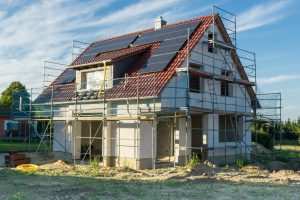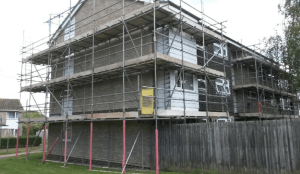The construction industry stands as a pillar of the UK’s economy, contributing significantly to employment, infrastructure development, and architectural evolution.
But as we marvel at towering skyscrapers and sprawling complexes, there’s an underlying element that’s crucial yet often overlooked – safety.
In a world where construction projects are ambitious and expansive, the importance of adhering to strict safety protocols and standards cannot be stressed enough.
Within the realm of building safety, one of the most vital components ensuring the welfare of workers and the structural integrity of buildings is scaffolding.
This temporary structure, often seen enveloping construction sites, is a key player in guaranteeing that projects proceed without a hitch and, most importantly, without harm.
Defining Scaffolding
Scaffolding, in its essence, is a temporary structure used to support workers and materials during the construction, maintenance, or repair of buildings and other large structures. It serves as a bridge, ensuring accessibility to areas that would otherwise be perilous.
Predominantly, scaffolding in the UK is made using robust materials like steel or aluminium, which provide both durability and stability.
Besides the primary materials, a scaffolding system also includes various components like boards, couplers, and guard rails, each playing a specific role in ensuring the structure’s safety and functionality.
When erected correctly, scaffolding offers an effective and efficient means to carry out construction tasks without compromising on safety.

Role of Scaffolding in Building Safety
Access and Mobility
One of the most immediate benefits of scaffolding is the secure access it offers to elevated and challenging-to-reach areas.
For construction workers, manoeuvring at great heights with heavy materials would be nearly impossible without this support.
Scaffolding ensures that workers can move freely, carrying tools and materials with them, without the constant fear of falling or dropping items from a height.
Support and Stability
Scaffolding is not merely an access tool; it also serves as a pivotal support system.
Whether it’s holding up workers, facilitating the storage of materials, or even temporarily shoring parts of the building, scaffolding ensures everything stays in place.
In the unpredictable UK weather, with sudden downpours and gusty winds, a stable scaffolding system is imperative.
This robust structure ensures that even in less-than-ideal conditions, work can progress without compromising on safety.
Fall Prevention and Protection
Every year, numerous accidents at construction sites are attributed to falls. With the inclusion of guardrails, toe boards, and sometimes safety nets, scaffolding plays a monumental role in minimising these risks.
But it isn’t just about having these components in place; regular safety inspections ensure that they remain effective throughout the project’s duration, providing consistent protection against potential falls.

Legal and Regulatory Implications
In the UK, scaffolding’s significance in construction safety is not merely a topic of discussion; it’s enshrined in law.
The Health and Safety Executive (HSE) has set out stringent regulations governing the use of scaffolding.
These standards delineate everything from the quality of materials to the frequency of safety inspections, all aimed at ensuring that scaffolding remains a bulwark of safety on construction sites.
Non-compliance with these regulations doesn’t merely pose a threat to safety; it comes with substantial legal consequences.
Companies found in breach of HSE scaffolding guidelines can face heavy fines, and in severe cases, imprisonment.
Such punitive measures underscore the gravity of the matter and the uncompromising stance of UK regulators on ensuring building safety.
The Economic Value of Proper Scaffolding
Some might argue that investing in high-quality scaffolding and adhering to strict regulations can be expensive. However, the long-term economic value derived from such investments cannot be overlooked.
Accidents, delays, and reworks are not just detrimental to a project’s timeline but also carry significant financial repercussions. Investing in top-notch scaffolding from the outset can prevent such unforeseen costs.
Furthermore, insurance premiums for construction projects are influenced by the measures taken to ensure safety.
A robust scaffolding system, compliant with all regulatory standards, can result in reduced premiums, saving construction firms substantial amounts in the long run.
In essence, proper scaffolding is not just a safety measure, but a wise economic decision.
Best Practices for Ensuring Scaffolding Safety
Selection and Quality
The foundation of any safe scaffolding system lies in its initial selection and the quality of materials used.
It’s paramount to choose the right type of scaffolding, be it fixed, mobile, or suspended, based on the specific requirements of the construction project.
Moreover, the materials used should be of the highest quality, devoid of any defects, ensuring longevity and resilience against environmental factors.
Regular Inspections
No matter how high the quality of the scaffolding is, without regular inspections, its safety can be compromised.
Daily checks by competent individuals can detect and rectify minor issues before they escalate.
Moreover, periodic thorough inspections are crucial, especially after adverse weather conditions or any significant modifications, ensuring that the scaffolding remains safe and fit for purpose.
Training
A scaffolding system is only as safe as the people erecting, modifying, and dismantling it. Therefore, it’s essential to ensure that all workers involved have received adequate training.
They should be well-versed with the best practices, aware of potential risks, and equipped with the knowledge to address any issues that may arise.
Training not only enhances safety but also improves efficiency, ensuring that projects progress smoothly.
Maintenance and Upkeep
Like any other structure, scaffolding is susceptible to wear and tear. Regular maintenance is essential to identify issues like rust, cracks, or any other defects that might compromise safety.
By addressing these concerns promptly and ensuring all components are in optimal condition, we can guarantee that the scaffolding remains a stalwart guardian of safety throughout its tenure.

Conclusion
In the vast landscape of construction, scaffolding stands as a silent sentinel, ensuring that every brick laid and every beam placed is done so with the utmost safety.
Its importance cannot be merely confined to rules and regulations; it is the embodiment of our commitment to safeguarding lives.
As the construction industry continues to evolve, one constant remains – the indispensable role of proper scaffolding.
For builders, workers, and stakeholders alike, it’s not just a structure; it’s a promise of safety, stability, and success.
Get in touch with us today if you are in need of our scaffolding services.

